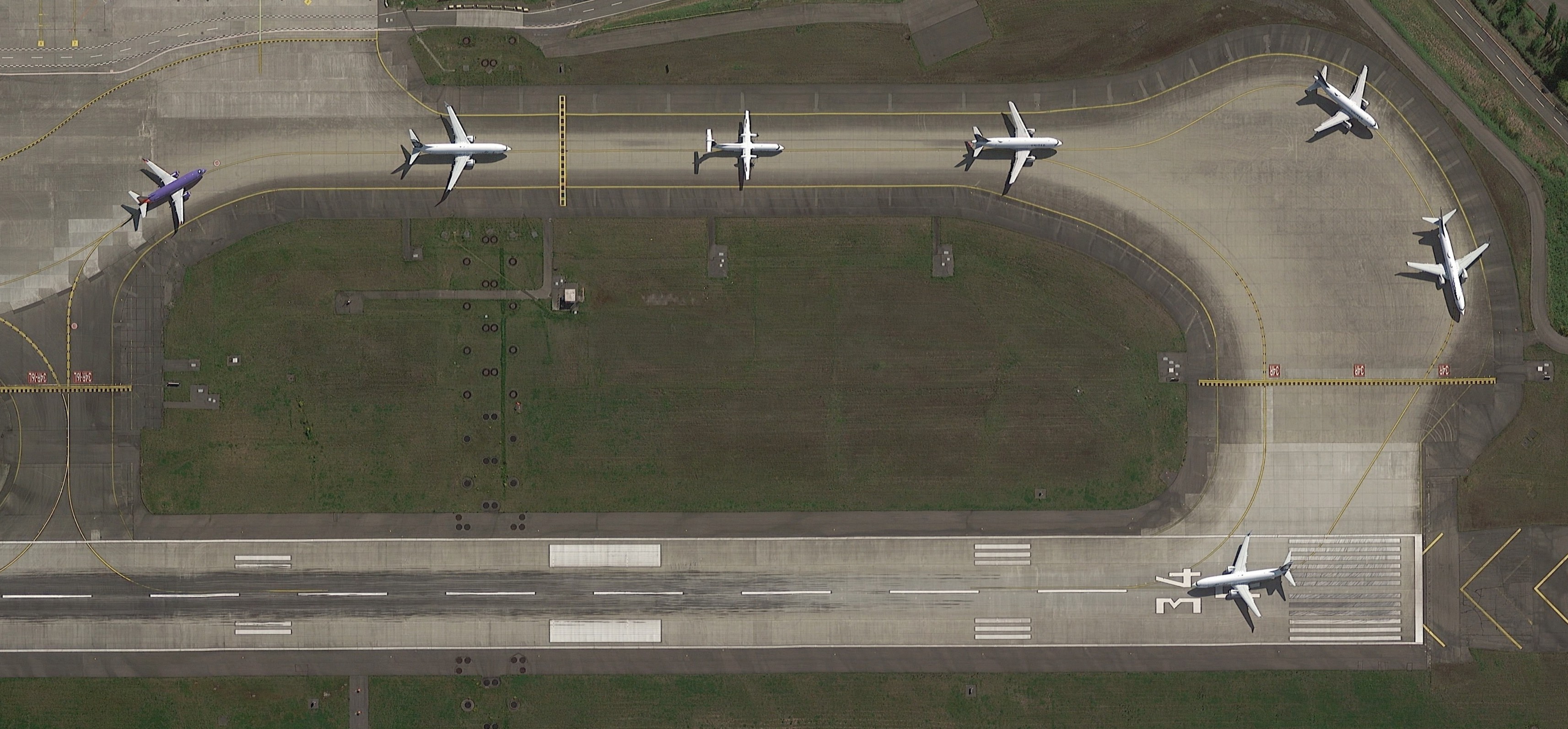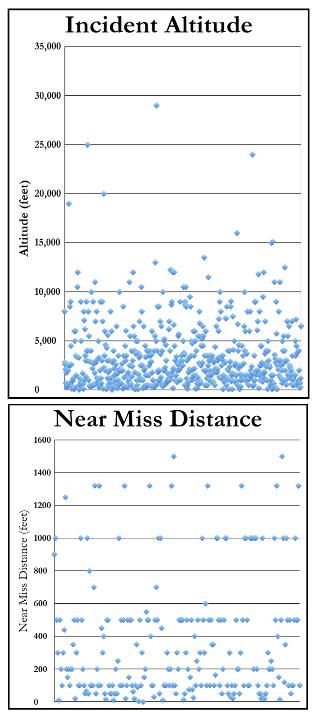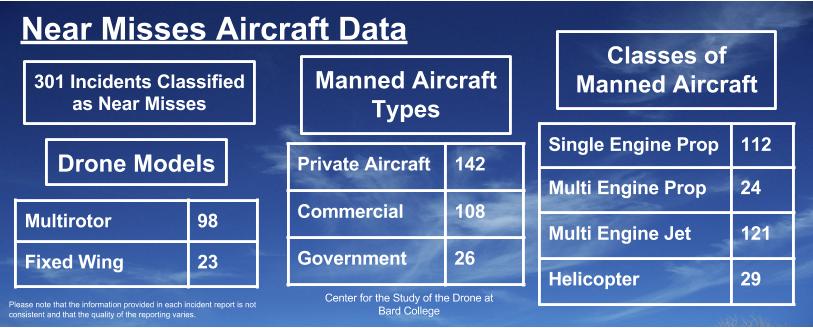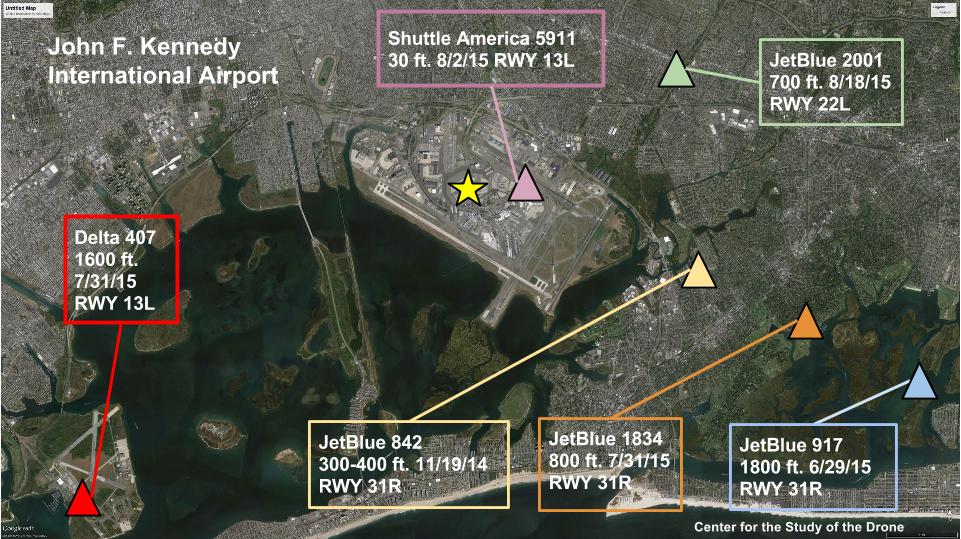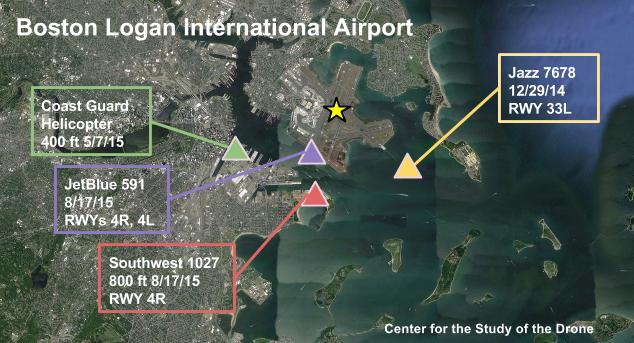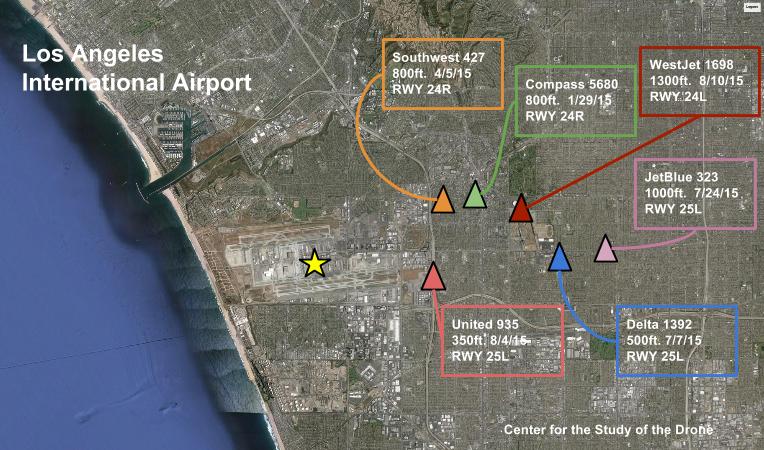As domestic drone use has expanded in recent years, so too has the number of incidents in which manned aircraft have come into close contact with drones, as well as incidents in which drones have been spotted flying either within five miles of an airport or over the designated ceiling for drones, which is 400 ft. In 2013, in one of the earliest highly publicized such incidents, an Alitalia flight on final approach to New York City’s JFK airport reported spotting a drone hovering 200 ft. away. Many worry that if even a small hobby drone were to be sucked into an aircraft’s jet engine, or were to collide with a propeller-driven aircraft, it could cause a significant accident. Earlier this month, the Federal Aviation Administration reported that so far this year there have been 650 such claimed sightings and near misses, a considerable increase over the 238 that were reported in 2014.
Last week, following a leak of its data to the Washington Post, the FAA publicly released all reports of close encounters and drone sightings from November, 2014 to the present month. These reports include the date, time, and location of each incident, as well as a so-called narrative that describes, in varying levels of detail, each encounter and sighting. Not every report includes all the same information; for example, while most reports state the altitude at which an incident occurred, some do not. We have conducted a preliminary analysis of these reports in order to extract the most significant data, as well as to draw any early and actionable conclusions about the nature of these encounters and sightings.
What we Found
We describe a near miss incident as when a drone comes within a measurable proximity to a manned aircraft, and when the proximity and heading of the aircraft presents some risk of collision. A sighting, on the other hand, is when a drone is spotted above its legal ceiling or in the vicinity of an airport or aircraft, but does not pose an immediate risk of collision. We analyzed the reports in order to determine whether each incident was a sighting or a near miss, based on factors such as the distance between the drone and the manned aircraft, the language used to describe the encounter, and whether or not the pilot needed to take evasive action to avoid a collision (which is quite rare). Of the incidents in the database, we counted 302 near misses and 404 sightings. The database also lists a small number of reports of drones flying in a way that does not interfere at all with air traffic, but which still raised concern among citizens or local law enforcement, such as drone flights over stadiums or the White House.
Distance from an Airport
Many of the highly publicized drone sightings, like the Alitalia Flight 608 incident, have involved manned aircraft on final approach to an airport or during initial climb following take-off. It is illegal to fly unmanned aircraft within five miles of any airport in the U.S without permission from air traffic control. Of the 552 incidents in which a distance from an airport was recorded, 324, or 58.6%, occurred within five miles, and 228, or 41.4%, occurred beyond five miles from the nearest airport. Some incidents occurred up to 30 miles away from the nearest airport. In other words, in about two out of five cases, a drone was not within an airport’s no-fly zone when it interfered with manned air traffic.
Of the 627 incidents in which an altitude was recorded, only 61, or 9.9%, occurred below 400 ft, which is the legal ceiling for recreational drone operations (the ceiling for commercial operations is 200 ft.). The median altitude for incidents was 2,200 ft, and the average altitude was 3,306 ft. In other words, in a majority of the cases in which a drone posed a potential danger to manned air traffic, it was flying several times higher than than the legal maximum altitude for civilian drone flights.
Near Miss Distance
Some near misses are closer than others. Of the 219 incidents in which a near miss distance was provided, the average near miss distance was 374 ft. and the median near miss distance was 200 ft. Many reports simply stated that a drone came “very close to” or “just above/below” the manned aircraft. In one incident, on April 27 at Livermore Airport in California, a small private aircraft appears to have in fact collided with an unmanned aircraft. The pilot reported hearing a loud thud during his flight, and upon landing discovered that the airplane “had sustained two gouges to the lower portion of the nose cowl about 3 inches long and deep enough to take off the first layer of fiberglass.”
Identifying the Drones
For the incident reports that contained enough identifying material, we have classified the types of drones that were reported. While many of the incident reports identified the drone in some way, the level of detail in descriptions varies widely and the exact model of drone is absent from the majority of the data. Instead, the reporting party—usually the pilot of a manned aircraft—identifies the drone by the color or size of the aircraft. For example, the pilot might report seeing a drone that was white and sported flashing lights or was three feet long. In some cases, the pilot likened the unidentified aircraft to some recognizable shape like a “crab” or a “dishwasher.” In many cases, the report notes that no description of the drone is available.
We were able to determine the type of drone in over a third of the reported incidents. We have identified 199 multirotor and 53 fixed wing drones in the dataset. Of these, 98 multirotors and 23 fixed wing drones were involved in a near miss incident. In other words, out of those incidents for which specific descriptions are available, multirotor drones are approximately four times as common as fixed wing drones. We classified the drones based on the reported dimensions of the aircraft, attributes such as the number of propellers, and the type of activity that the drone was engaged in at the time. For example, if the pilot reports a drone with multiple propellers that’s 1 ft. by 1 ft. and that is hovering above them, the drone is clearly a multirotor. Whereas if the drone is described as having wings and a length of 3-4 ft., it is more than likely that it is a fixed wing aircraft. Although we included in our dataset other descriptors such as the color of the drone or whether it had lights, we did not factor these attributes into our classification of the aircraft.
A small number of other reports describe the unmanned aircraft as a helicopter-type drone or an aircraft with a single propeller.
Manned Aircraft Types
We analyzed the data to determine what kinds of manned aircraft were involved in the incidents that we counted as Near Misses. This information is important, as a collision between a single engine propeller-driven aircraft and different from a collision between a multi engine jet and a drone. Of the 302 near misses, 113 involved single engine propeller-driven aircraft, 29 involved multi-propeller aircraft, and 121 involved multi engine jet aircraft (which range in size from small corporate jets to large commercial airliners). In other words, roughly four in 10 near misses involved jet powered manned aircraft. We also analyzed whether manned aircraft were operated privately, commercially, or for the government (which includes the U.S. military). We found that 143, just over half, involved private aircraft, which includes private and chartered jets; 108 involved commercial aircraft, which were predominantly multi engine jets, and 26 involved government aircraft, such as military transport planes, emergency services helicopters, and firefighting aircraft. We found that 99 near misses, over one in three, involved commercial multi engine jets.
Mapping the Incidents
Some of America’s busier airports have had dozens of sightings and near misses. Of these, however, only a few take place within the immediate vicinity of an airport, occasionally interrupting arrivals traffic. Using the information reported by pilots and arrival charts for New York’s John F. Kennedy International Airport, the Los Angeles International Airport, and Boston’s Logan International Airport, we have plotted the approximate location where the a few of the drones were flying at the time of sightings and near misses.
Each aircraft landing at an airport follows a specific path to a particular runway that runs according to certain waypoints and altitudes requirements. In the images below, we have included the flight number of the manned aircraft, the height at which the drone was spotted, the date of the incident, and the runway where the aircraft was routed to or from. Airport charts and air traffic recordings from sites like AirNav.com and LiveATC.net as well as Google Earth’s measurement tools were helpful in our search for some clarity on the drone sightings.
[gview file=”http://dronecenter.bard.edu/files/2015/08/Near-Misses_1-Master-1.pdf”]
This data was originally published on August 28, 2015.
For updates, news, and commentary, follow us on Twitter.
[includeme file=”tools/sympa/drones_sub.php”]

